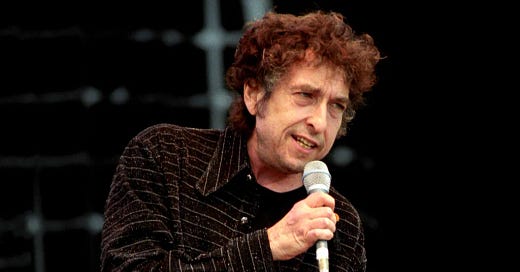Bob Dylan into the Lighthouse: 3,000 More Shows to Come
BOB DYLAN
Live Concert into the Never-Ending Tour— Palmer Auditorium, Austin, Texas, 9/9/1990
The Joker
Reviewed by Luke Torn
Bob Dylan has been confounding writers, scholars, musicians, and fans for many years now. From his first celebration break with public expectations—his influential and groundbreaking decision to go electric at the 1965 Newport Folk Festival—he’s been a restless soul. Never content to stay in one place for too long. Dylan’s career has been marked by abrupt and unexpected musical and lyric changes. One constant, though, since his 1974 comeback tour, has been the road. And if you’ve followed his live albums or his tours over those years, you know that Bob likes to play little games with his songs from time to time.
How does a man who has written so many amazing songs keep from getting bored playing them over and over for 25-30 years? The last thing Bob Dylan wants to be is a musical museum piece. So he fends off nostalgia trips by rearranging his old songs—never singing them the same way twice. At the same time, he knows which side his bread is buttered on, playing a healthy mix of songs he knows his fans want to hear, and keeping the newer, lesser-known stuff to a minimum. (He played nothing from the brand new Under the Red Sky at Sunday night’s concert and only two selections from last year’s Oh Mercy, though the latter’s “Shooting Star” was fabulous, proof that his songwriting is sometimes as sharp as it ever was.) By show’s end, I’d almost felt Dylan had played his whole back catalog. Many songs contained instrumental passages and twisted fragments of other songs. The surprise Blonde on Blonde cut, “Pledging My Time,” sounded more like “Pledging My Time to Your Brand New Leopard-Skin Pull-Box Hat.”
The chugging “Man of Peace” sounded as if he’d finally perfected the slow rumble of “Slow Train Coming” into a timeless locomotive blues. “Desolation Row,” a song performed rarely on stage, lost its little between-verse guitar riff and sounded more like some lost Pat Garrett & Billy the Kid number than the epic mid-‘60s classic it is. Several times B-side, “The Groom’s Still Waiting At the Alter.” His tinkering with his own song structures might have thrown a few fans off balance, but it’s also kept Dylan interested and enthusiastic about his own work over his long years on the road. Sunday, Bob Dylan was emphasizing how the songs feel now, without regard to their place in history and certainly without regard to how they were played on record. And in that sense, the show was more of a celebration of the present, a difficult thing to pull off given the legacy of many of these songs.
Contrary to Bob Dylan’s stage reputation, Sunday night’s show was positively cheery. Dressed in white shirt, black pants, and black work boots, Dylan looked like a cross between the friendly father-figure of New Morning and the scraggly hard rocker of Empire Burlesque. He actually spoke to the audience (gasp!) and, about halfway through, even joked that it was good to finally be back in his hometown (the place he played with The Band, Municipal Auditorium, Austin, TX, September 24, 1965) . From the opening bell, into “Marines’ Hymn”—a song by Jacques Offenbach—Bob was grooving—somehow turning the douse “Tangled Up in Blue” into an instant party. An enthusiastic smile crossed his face from time to time and this unexpected warmth rubbed off on the crowd. Dylan’s four-piece band, led by Saturday Night Live guitarist G.E. Smith, was tight, lending sympathetic backing to the ballads, and playing with ferocious abandon on the rockers. A fiery version of “All Along the Watchtower,” with a clever little Jimi Hendrix-like coda, had Dylan closing his eyes in appreciation of Smith’s soaring solo. A quiet, near acoustic set halfway through the show yielded a passionate and powerful “It’s Alright Ma (I’m Only Bleeding).” “I Want You” rolled along with a gentle, angelic lilt. The early highlight was a killer rendition of Little Feat’s truck driving anthem “Willin’,” which elicited smiles all around. Dylan was upbeat, smiling, dancing. Later, a spellbinding “Every Grain of Sand,” given a bit more rhythmic oomph and guitar brawn that its recorded counterpart, captured the audience with its undeniable grandeur. Even the old warhorse “Masters of War,” which Dylan inexplicably drags out of the closet on every tour, sounded good with the controls revved up to eleven and Smith wailing away righteously on guitar. A brief two-song encore, including a ragged put right version of “Blowing in the Wind,” ended it after 90 minutes, though the crowd was primed for a second set that would never come.
Luke Torn



